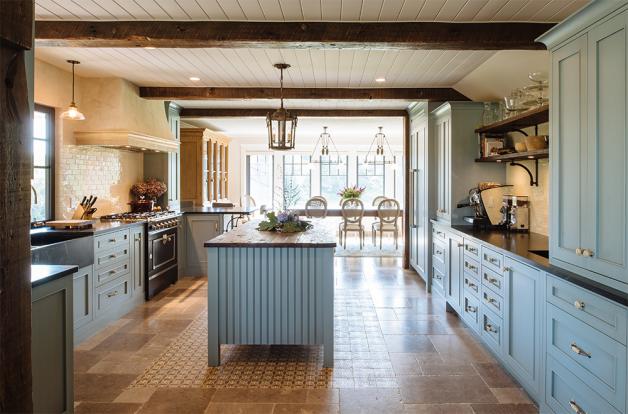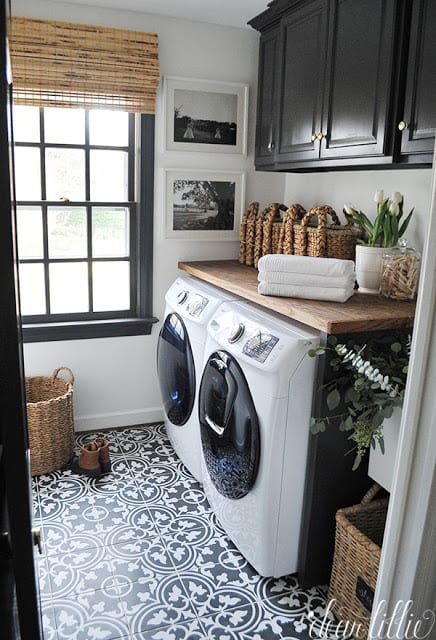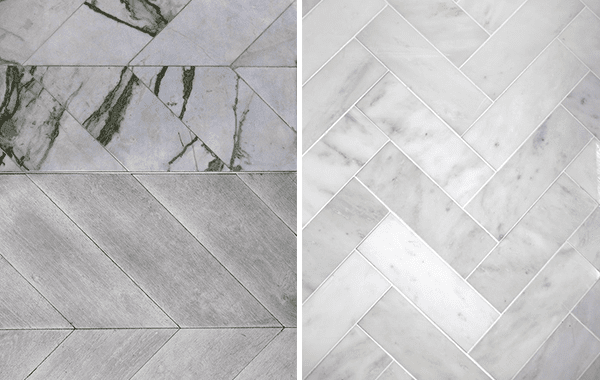
Thanks for following along in our flooring series! If you haven’t yet, check out Part One of this series on Hardwood Floors.
In this post we will be giving some great info from our designers on tile flooring: information on types of tile, installation tips, trends and more! Read on for more great info.
Tile is a great flooring option for areas of your home that might be exposed to water, such as kitchens, bathrooms, laundry rooms and entrance ways. It tends to be a durable flooring option that can withstand wear and tear, dirt, mud, accidental spills and more.
There has been a huge surge in tile options over the last number of years. Shapes, colors and patterns, there are so many options available in today’s market!
Tile Types
Porcelain is the type of tile we are seeing and currently using the most often for our homeowners. Not only does it have the most variety in color and pattern, it also is much stronger, less porous and less likely to crack than natural stone and even ceramic. Porcelain tile is actually a type of ceramic tile, but made with a much finer clay and fired at higher temperatures. It is more resistant to wear and abrasion and is also moisture resistant. Porcelain tile is often chosen for its consistent patterning.
Real stone (IE Marble, travertine and limestone) are beautiful, but are more porous and require sealing (and regular resealing). Due to the nature of real stone, the patterning will be more varied and have less consistency. However, natural stone does tend to be warmer, and will also distribute in-floor heating more consistently than its man-made counterpart.
Designer tip: If it’s in your budget, consider adding in-floor heating with tile! In our cooler months here in the Greater Vancouver area, having in-floor heating is a nice luxury, especially for bathrooms such as the en suite.
Mosaic Tile
In the design world, smaller mosaic tiles are all the rage. They are great for small spaces like a powder room. They can also work well for a sloped shower floor due to the smaller tile size. However, they can be up to three times more expensive, and harder to clean as there are more grout lines, so keep that in mind if you love the look. Choose a small room or an area in your home where you can feature your favorite mosaic tile as an inset pattern, either in a front entry or bathroom. Or like one of our homeowners did with these custom hand painted tiles beneath their kitchen island (see photo above!).
Cement Tile
We have had a few clients express interest in cement tile and we are seeing an increased interest in the design world for these beautifully patterned high end specialty tiles. You can find more information here from our friends at Villa Lagoon Tile on how these tiles are handmade, installation details and required maintenance.
These aren’t in the budget for every homeowner, but there are some great porcelain tile alternatives, like these tiles in Dear Lillie‘s laundry room that give the look of cement tiles, but at a much lower cost:
Shaped Tile
Tiles in various shapes have been gaining momentum in the design world, and shapes such as hexagon, scallop and arabesque are all popular choices. While these tiles aren’t always used in flooring (more commonly used for back-splashes) they can be used similarly to mosaic
Another popular trend we are seeing are larger format tiles (ie 18×36 or 24×48). These types of tiles not only tend to be easier to clean due to less grout lines, they also lend a clean and modern look to your space.
A current popular trend is to install tiles in a pattern such herringbone and chevron. While it is more expensive to install tiles this way, it can look stunning!
Grout
Typically we recommend avoiding white or light grout. Light grout can be difficult to maintain and tends to discolor over the years. Match your grout to the tile, or go with a darker grout to create some contrast and make a statement. If you want to have minimal grout lines, consider choosing a rectified tile (a tile that has had the edges mechanically finished for a more precise size) that allows for a smaller grout line.
Thank you for following along on our flooring series, we hope you’ve found this information useful! We’ll be back with one more post on some alternative flooring choices.





